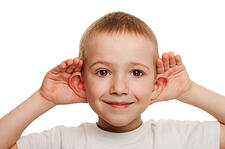 What is “hearing acuity”? What does it have to do with auditory processing disorder and our ability to learn?
What is “hearing acuity”? What does it have to do with auditory processing disorder and our ability to learn?
LearnFast asked Devon Barnes, speech pathologist and Auditory Processing Disorder specialist to explain the links between a child’s ear structure, their hearing acuity, auditory processing disorder and learning ability.
Key points from the interview included
- Hearing acuity refers to the very softest sound we can hear across a range of frequencies.
- Hearing is fundamental to learning language.
- Ear infection or “glue ear” can cause problems for children
Prefer to read the video transcript? Here it is.
How a Child's Ear Structure can Impact Their Ability to Process What They Hear
Interviewer: So, Devon, auditory processing and hearing acuity, they sound like big words. What's the mystery?
Devon Barnes: Hearing acuity refers to the very softest sound we can hear across a range of frequencies. The human ear can hear up to about 8000 Hertz which is how we measure frequency, or cycles per second in the old language.
Interviewer: Yeah.
Devon Barnes: So when we have our hearing tested, we're looking at that range of sounds, the very softest sound we can hear across that range of frequencies. So we look at loudness versus softness and low versus high frequency and hearing acuity happens just within the ear, particularly in the cochlea.
Interviewer: OK. So when we think about dogs being able to hear very high sounds, they can hear much higher than 8000 Hertz?
Devon Barnes: They can I believe.
Interviewer: Right. OK. So how does hearing acuity then link in with auditory processing and our ability to learn?
Devon Barnes: Well, to start off with, we will not learn language if we can't hear. Hearing is fundamental to learning language and many things can impact on a child's development of their auditory processing if their hearing is interrupted in those early years.
Interviewer: Right. OK. So if there's a gap in the hearing or if a hearing problem isn't diagnosed early, then the problem is compounded?
Devon Barnes: Exactly. We know in children, their ear structures are very small, so they're very prone to ear infection or glue ear which is an accumulation of fluid in the middle ear which prevents the sound signal getting through to the inner ear.
Interviewer: OK. So in a classroom situation, getting back to what we said before, if you've got a really noisy classroom, someone who's got a hearing acuity problem is going to be struggling big time, right?
Devon Barnes: Absolutely. Yes, and we need to distinguish between hearing acuity and auditory processing, but hearing acuity is the very first thing we need to look at because we need to know how well the child hears before we can assess how they process what they're hearing. And obviously if you have a hearing loss, that will affect your processing.
Interviewer: Yeah, so if you've got a student who is looking like they are perhaps not getting the message or something like that, is it worthwhile perhaps having a chat to someone saying, "Look, maybe this person just needs to have their hearing tested?"
Devon Barnes: The very first thing you would do is make sure they have a hearing test and check out that there is no structural issue with their hearing acuity.
Interviewer: Right. Because there is a direct link between hearing acuity and the ability to learn.
Devon Barnes: Absolutely. In a classroom, if you're not hearing properly you won't learn, but also there are that whole group of children that we are talking about who have fine hearing acuity, but don't process effectively.
Interviewer: Yeah, I was going to ask you about that. So if one of the two isn't working, that's enough to cause a problem?
Devon Barnes: Yes.
Interviewer: Right. OK. That sounds pretty obvious, I guess. So let's take it to the next level then. What if someone actually has both of those problems? Is this a disaster or can we treat it?
Devon Barnes: Oh, it's all very treatable. If there is a hearing loss, first of all, we'd want to know what's causing that. We have two kinds of hearing loss. One we call a conductive loss where there's a blockage with the sound going through at the level of either the ear canal or the middle ear.
Interviewer: Right. OK.
Devon Barnes: The ear basically has three parts. The ear canal is the thing you shouldn't stick anything sharper in than your elbow.
Interviewer: That's the bit on the outside, right?
Devon Barnes: That's it, the canal where the sound goes. And then we come to the eardrum and then beyond the eardrum is what we call the middle ear which is basically an air-filled cavity which has a connection through the back of the throat called the Eustachian tube and the job of the Eustachian tube is to keep the air pressure equal on the ear drum.
Now, in many children, particularly small children, it's the middle ear that can fill up with fluid. When they develop an ear infection, the middle ear becomes full of junk, you could say or muck. And so what happens is sound travels through the ear. Sound is just vibration.
So the job of the eardrum and the little bones in the middle ear, the ossicles, they vibrate and they transfer that vibration to the inner ear. The inner ear is where we have the organ of hearing, the cochlea.
So if there's any disruption to either the ear canal, and that can be just a build up of wax in the ear canal which can cause hearing loss, or something going wrong in the middle ear with a build up of fluid or an ear infection, that sound vibration can't effectively be delivered to inner ear where we can actually hear.
Interviewer: Right.
Devon Barnes: So a conductive hearing loss refers to something going wrong in either the ear canal or the middle ear.
Interviewer: OK.
Devon Barnes: Some children then can have a problem with the actual organ of hearing itself, the cochlea. We refer to that as a sensori-neural loss.
Interviewer: OK.
Devon Barnes: That can't be treated, unless today, if it's a profound loss, they might get a cochlear implant.
Interviewer: Yes.
Devon Barnes: So that's the wonderful thing today with technology. Conductive hearing problems are very easily treated. So if it's a chronic middle ear problem with fluid build up, you might have heard of grommets.
Interviewer: Mm, yes.
Devon Barnes: They insert a little tube a bit like mini cotton reel.
Interviewer: Like they cut a hole in the drum so to speak.
Devon Barnes: That's right. They make a little hole in the drum, put a little drainage tube in, and that drains the fluid from the middle ear. That's very easily treated.
Interviewer: So it sounds to me like there's a bit of a, if you like, putting it into computer terms, there's a hardware and software issue here. So you can have a hardware problem and a software problem, so they can be, as you said, a neural issue happening and that's the processing part, and then there's the physical bit that's the acuity part.
Devon Barnes: Well, even the neural bit really can, even before we get to that processing, if there's a problem in the cochlea, that's going to affect your hearing acuity.
Interviewer: Right. OK. Well, this sounds like it's getting even more complex. We'll see what happens in further videos. Thanks, Devon.
Related Posts
Could Auditory Processing Disorder be the Reason Your Child is Struggling to Read?
What is Auditory Processing Disorder?
Eight Tips to Help Your APD Child at Home
How strong is the link between Auditory Processing Disorder & Dyslexia?



